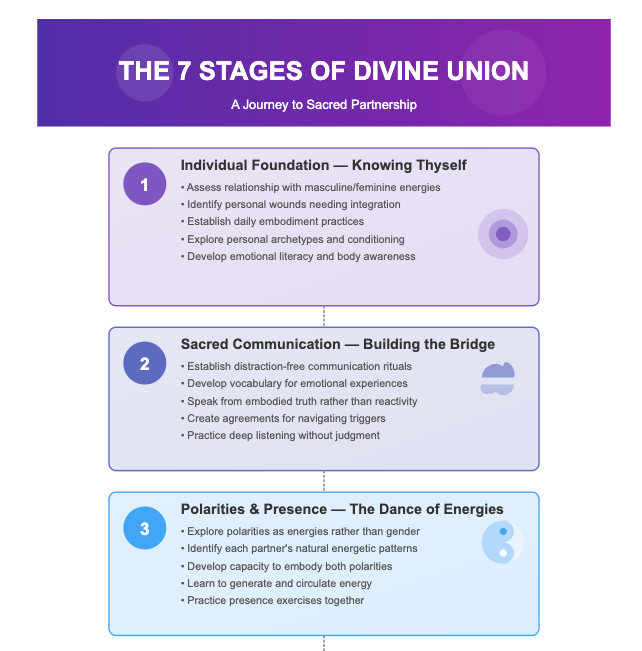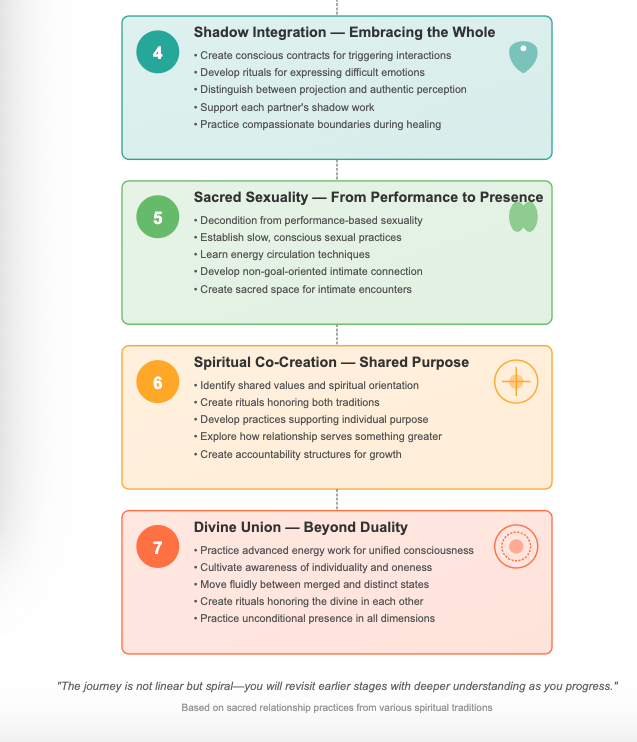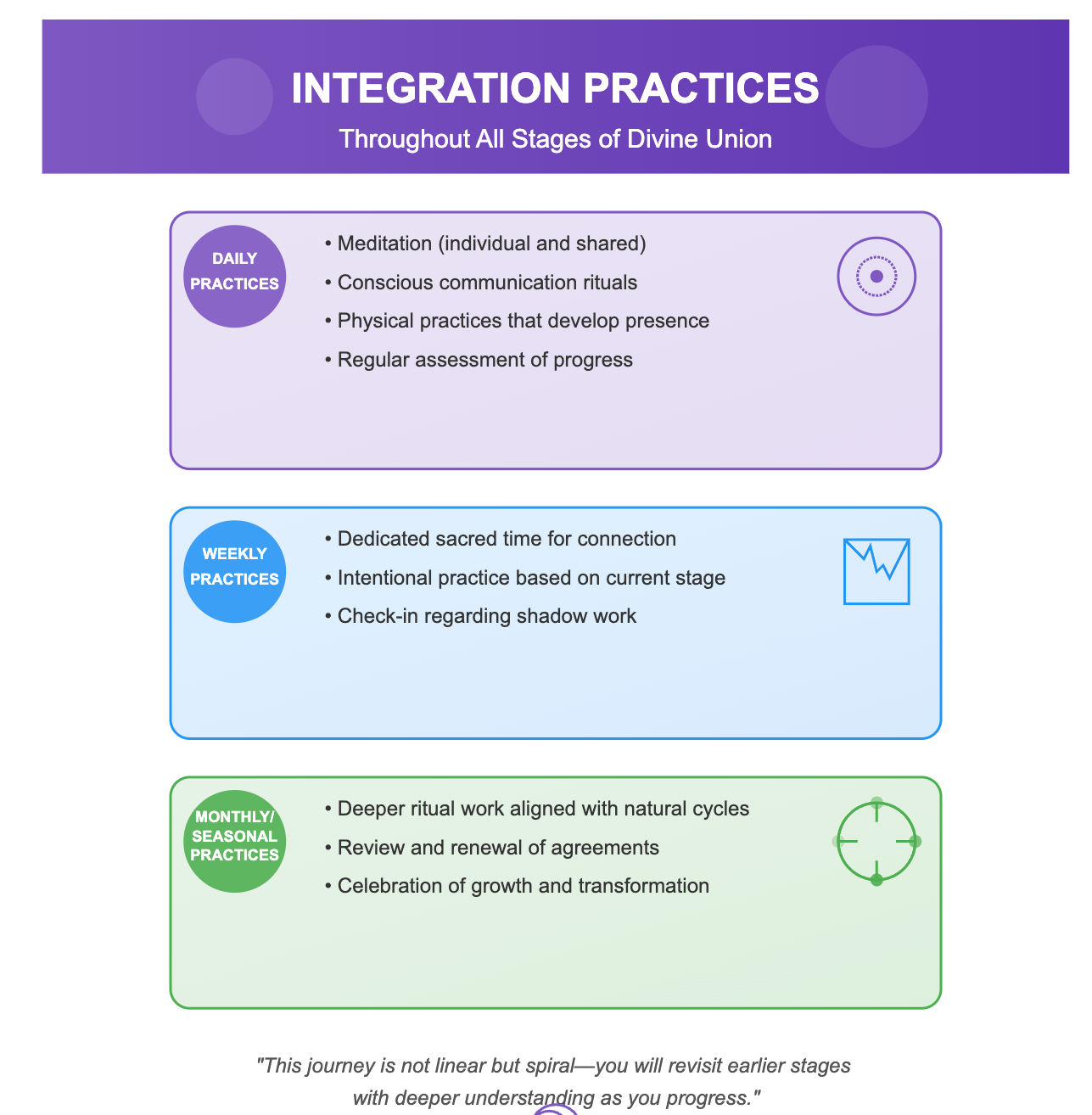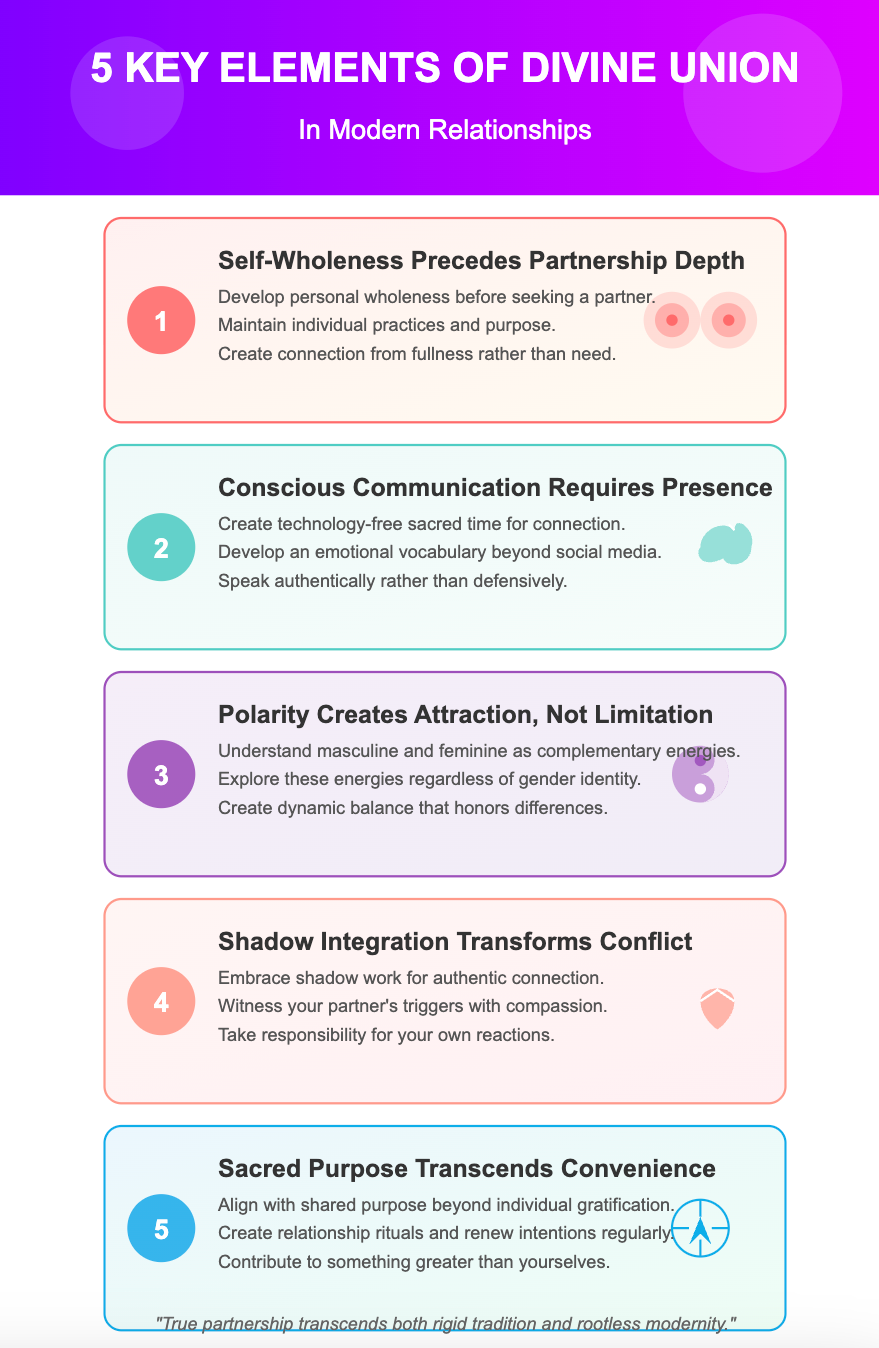Introduction
In today's hyper-connected yet emotionally disconnected world, the concept of divine union offers a revolutionary pathway to deeper relationship fulfillment.
While ancient wisdom traditions have long recognized the sacred potential of human partnership, modern couples face unprecedented challenges—digital distractions, burnout culture, and relationship models that prioritize convenience over depth.
The seven-stage journey to divine union presented by spiritual teachers from Paulo Coelho to David Deida isn't just for mystics or tantric practitioners; it's a practical framework for any couple seeking authentic connection beyond surface-level companionship.
This transformative approach begins with individual wholeness rather than codependent completion, challenging the modern myth that the right partner will "complete us." Instead, it invites us to become conscious creators of relationship as a spiritual practice—a vehicle for growth, purpose, and transcendence in an age desperately needing genuine human connection.


7 stages of divine union
Stage 1: Individual Foundation — Knowing Thyself
Core Focus: Self-awareness and personal healing
For All Partners:
- Honest assessment of your relationship with masculine and feminine energies within yourself
- Identifying personal wounds and shadows requiring integration
- Establishing daily practices for embodied presence (meditation, breathwork, somatic awareness)
Masculine Journey Work:
- Exploring the four archetypes (King, Warrior, Magician, Lover) from Moore & Gillette
- Addressing the father wound and early conditioning (Hollis's "Under Saturn's Shadow")
- Developing emotional literacy beyond cultural limitations (Masters's "To Be A Man")
Feminine Journey Work:
- Reconnecting with instinctual nature (Estés's "Women Who Run With Wolves")
- Exploring feminine archetypes and cyclical wisdom (Walker, Tanishka)
- Body-centered reclamation practices (Kent's "Wild Feminine")
Milestone: Both partners have established independent spiritual practices and begun integration of their shadows.
Stage 2: Sacred Communication — Building the Bridge
Core Focus: Creating safety and transparency between partners
Practices:
- Establishing communication rituals free from distraction
- Developing vocabulary for spiritual and emotional experiences
- Learning to speak from embodied truth rather than reactivity
- Creating agreements for navigating triggers and challenges
- Practicing deep listening without interruption or judgment
Book References:
- "Intimate Communion" (Deida)
- "The Essence of Tantric Sexuality" (Michaels & Johnson)
Milestone: Partners can navigate difficult conversations while maintaining connection and respect.
Stage 3: Polarities & Presence — The Dance of Energies
Core Focus: Understanding and honoring energetic differences
Practices:
- Exploring masculine/feminine polarity as energies rather than gender
- Identifying each partner's natural energetic patterns
- Developing capacity to embody both polarities consciously
- Learning to generate and circulate sexual energy without physical expression
- Practicing presence exercises together (eye gazing, synchronized breathing)
Book References:
- "The Way of the Superior Man" (Deida)
- "Awakening Shakti" (Kempton)
- "The Heart of Tantric Sex" (Richardson)
Milestone: Partners understand and appreciate their energetic differences as complementary rather than problematic.
Stage 4: Shadow Integration — Embracing the Whole
Core Focus: Mutual support through healing deeper wounds
Practices:
- Creating conscious contracts for triggering interactions
- Developing rituals for expressing and witnessing difficult emotions
- Learning to distinguish between projection and authentic perception
- Supporting each partner's descent into personal shadow work
- Practicing compassionate boundaries during healing processes
Book References:
- "Fire in the Belly" (Keen)
- "Burning Woman" (Pearce)
- "Descent to the Goddess" (Perera)
Milestone: Partners can witness each other's shadow aspects without taking them personally or trying to fix them.
Stage 5: Sacred Sexuality — From Performance to Presence
Core Focus: Transforming sexual connection into spiritual practice
Practices:
- Deconditioning from performance-based sexuality
- Establishing slow, conscious sexual practices
- Learning energy circulation techniques for both partners
- Developing non-goal-oriented intimate connection
- Creating sacred space and ritual for sexual encounters
Book References:
- "The Heart of Tantric Sex" (Richardson)
- "Urban Tantra" (Carrellas)
- "The Art of Sexual Ecstasy" (Anand)
- "Divine Sexuality" (Muir & Muir)
Milestone: Partners experience sexuality as a sacred exchange of energy rather than a performance or release.
Stage 6: Spiritual Co-Creation — Shared Purpose
Core Focus: Aligning individual purpose with partnership vision
Practices:
- Identifying shared values and spiritual orientation
- Creating rituals that honor both traditions and perspectives
- Developing practices that support each partner's individual purpose
- Exploring how the relationship serves something greater than itself
- Creating mutual accountability structures for spiritual growth
Book References:
- "The Hidden Spirituality of Men" (Fox)
- "Tantra: The Supreme Understanding" (Osho)
- "Tantric Transformation" (Osho)
Milestone: Partnership has clear shared purpose that honors both individual paths while creating something greater together.
Stage 7: Divine Union — Beyond Duality
Core Focus: Transcending separate self while maintaining unique expression
Practices:
- Advanced energy practices for unified consciousness
- Cultivating simultaneous awareness of individuality and oneness
- Developing capacity to move fluidly between merged and distinct states
- Creating rituals that honor the divine in each other
- Practicing unconditional presence in all dimensions of relationship
Book References:
- "Tantra: Path of Ecstasy" (Feuerstein)
- "Tantric Quest: An Encounter with Absolute Love" (Odier)
Milestone: Partners experience states of unified consciousness while maintaining healthy individuality and purpose.
Integration Practices Throughout All Stages
Daily Practices:
- Meditation (individual and shared)
- Conscious communication rituals
- Physical practices that develop presence and embodiment
- Regular assessment of individual and shared progress
Weekly Practices:
- Dedicated sacred time for connection without agenda
- Intentional practice based on current stage of development
- Check-in regarding individual shadow work and integration
Monthly/Seasonal Practices:
- Deeper ritual work aligned with natural cycles
- Review and renewal of agreements and intentions
- Celebration of growth and transformation

Remember that this journey is not linear but spiral—you will revisit earlier stages with deeper understanding as you progress. The ultimate goal is not a fixed destination but an ever-evolving dance of consciousness, love, and purpose between two whole beings choosing union from freedom rather than need.
Conclusion
The path to divine union isn't separate from modern life but rather offers a sacred framework for navigating its complexities with greater consciousness and purpose.
As we've explored, this journey isn't about achieving relationship perfection but embracing a continuous spiral of growth—returning to foundational practices with deeper understanding as we evolve together. What distinguishes this approach from conventional relationship advice is its recognition that true partnership transcends both rigid tradition and rootless modernity, offering instead a dynamic balance of ancient wisdom and contemporary awareness.
The most profound relationships emerge not when we find the "perfect person" but when two individuals commit to their own wholeness while creating something greater together.
In a culture that often trivializes commitment as limitation, the divine union path reveals a paradoxical truth: it is precisely through conscious dedication to our highest values, authentic expression, and mutual growth that we experience the freedom, aliveness, and purpose we truly seek.
The question isn't whether such depth is possible in modern relationships but whether we're brave enough to pioneer this path—one conscious choice, one present moment, one act of courage at a time.
Summary with 5 Key Takeaways for Modern Relationships
The journey to divine union represents a comprehensive approach to relationship development that integrates spiritual wisdom with practical application. Drawing from diverse traditions and contemporary authors, this pathway offers a progressive framework for couples seeking deeper connection and meaning. Rather than bypassing challenges through spiritual platitudes, it provides concrete practices for navigating difficulties while maintaining authentic presence. The journey begins with individual foundation work, progresses through communication, polarity understanding, and shadow integration, then expands into sacred sexuality and shared purpose before culminating in transcendent connection.
5 Key Takeaways for Modern Relationships:

- Self-Wholeness Precedes Partnership Depth: Instead of seeking someone to complete you, the divine union approach emphasizes developing personal wholeness first. Modern relationships thrive when both partners maintain individual spiritual practices, emotional intelligence, and purpose, creating connection from fullness rather than need. This counters the app-based dating culture that treats relationships as consumption rather than co-creation.
- Conscious Communication Requires Presence: In an age of constant distraction, divine partnerships are built on communication practices that prioritize full presence. This means creating technology-free sacred time, developing emotional vocabulary beyond the limited range offered by social media, and learning to speak authentically rather than defensively. These skills develop the psychological safety essential for vulnerability in an increasingly uncertain world.
- Polarity Creates Attraction, Not Limitation: Understanding masculine and feminine energies as complementary forces rather than gender stereotypes provides modern couples with a framework for maintaining attraction amid equality. By consciously exploring these energies regardless of gender identity, partners can create dynamic balance that honors both individual expression and the magnetic power of difference.
- Shadow Integration Transforms Conflict: Rather than avoiding difficult emotions or using "conscious language" to bypass genuine feelings, the divine union approach embraces shadow work as essential for authentic connection. This means learning to witness your partner's triggers and wounds with compassion while taking responsibility for your own reactions—creating relationships that heal rather than perpetuate generational patterns.
- Sacred Purpose Transcends Convenience: Divine partnerships are sustained by alignment with shared purpose beyond individual gratification. In a culture that often treats relationships as disposable when challenges arise, committing to a higher vision creates resilience and meaning. This involves regular renewal of intentions, creation of relationship rituals, and conscious contribution to something greater than yourselves.
By implementing these principles, modern couples can transform their relationships from convenient arrangements into sacred partnerships that support both individual growth and collective evolution in an increasingly complex world.




